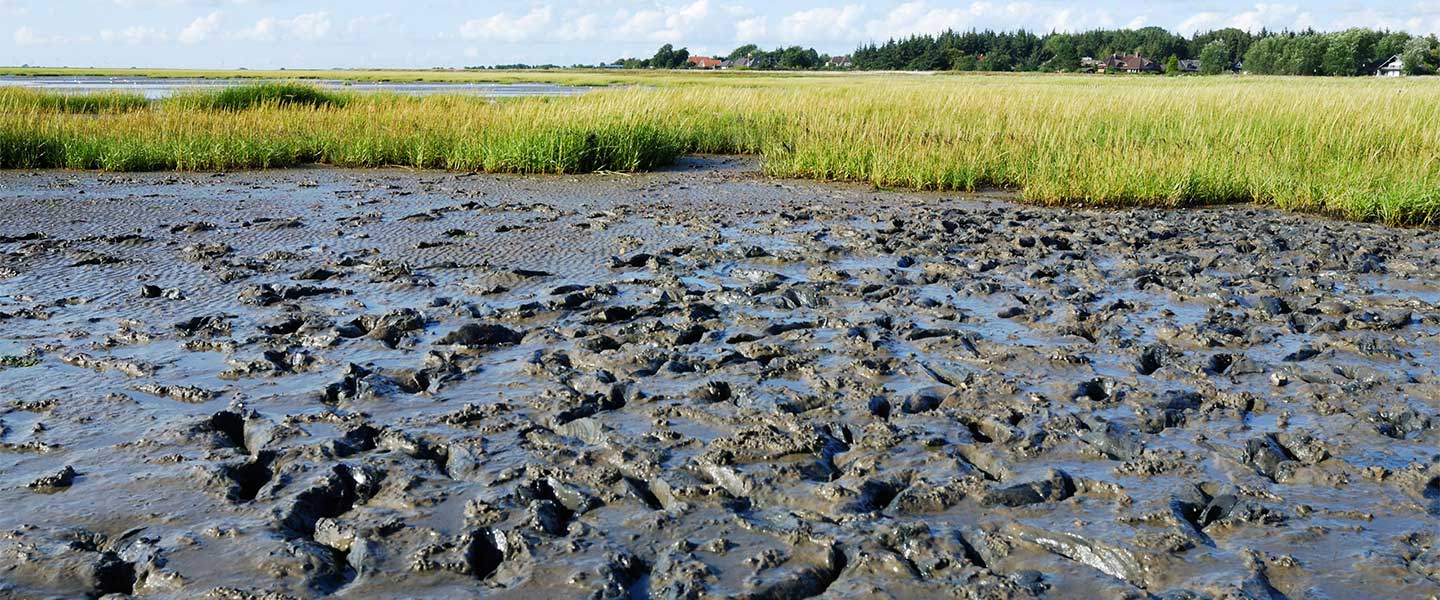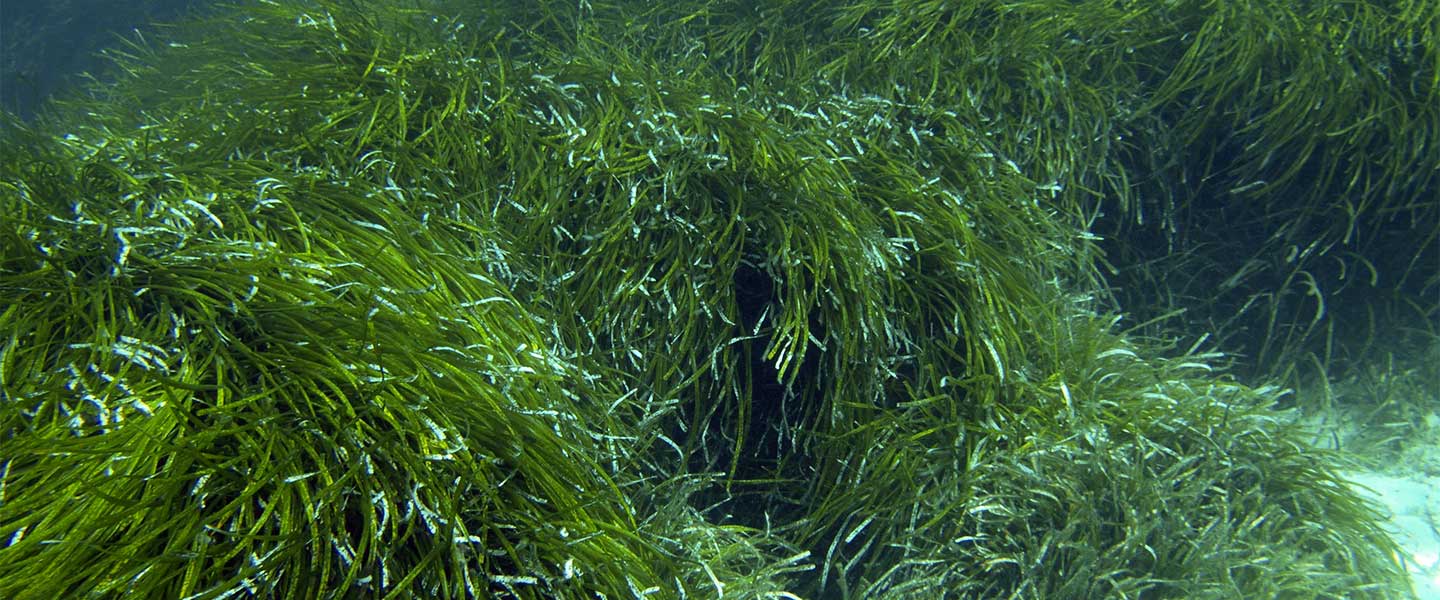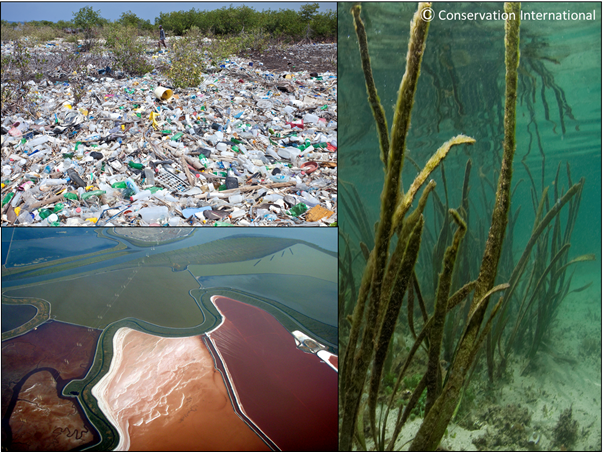ABOUT BLUE CARBON
The coastal ecosystems of mangroves, tidal marshes, and seagrass meadows provide numerous benefits and services that are essential for climate change adaptation along coasts globally, including protection from storms and sea level rise, prevention of shoreline erosion, regulation of coastal water quality, provision of habitat for commercially important fisheries and endangered marine species, and food security for many coastal communities. Additionally, these ecosystems sequester and store significant amounts of coastal blue carbon from the atmosphere and ocean and hence are now recognized for their role in mitigating climate change.
Despite these benefits and services, coastal blue carbon ecosystems are some of the most threatened ecosystems on Earth, with an estimated 340,000 to 980,000 hectares being destroyed each year. It is estimated that up to 67% and at least 35% and 29% of the global coverage of mangroves tidal marshes and seagrass meadows respectively have been lost. If these trends continue at current rates, a further 30–40% of tidal marshes and seagrasses and nearly all unprotected mangroves could be lost in the next 100 years. When degraded or lost, these ecosystems can become significant sources of the greenhouse gas carbon dioxide.
What are blue carbon ecosystems?
Mangroves
Few remaining mangroves surrounding the Bay of Diego
Mangroves are a type of tropical forest, found at the edge of land and sea and flooded regularly by tidal water. Mangroves are among the most carbon-rich forests in the tropics *. It is estimated that the average annual carbon sequestration rate for mangroves averages between 6 to 8 Mg CO₂e/ha (tons of CO₂ equivalent per hectare). These rates are about two to four times greater than global rates observed in mature tropical forests *.
Mangroves provide at least US $1.6 billion each year in ecosystem services, which include: supporting fisheries by providing important spawning grounds for commercial fish species; filtering pollutants and contaminants from coastal waters and contributing to healthy coastal marine water quality; and protecting coastal development and communities against storms, floods and erosion *.
In the last 50 years, between 30-50% of mangroves have been lost globally and they continue to be lost at a rate of 2% each year *. Major causes of destruction to mangrove ecosystems include deforestation for construction of aquaculture ponds and other forms of unsustainable coastal development. Experts estimate that emissions from the degradation of mangroves can be as high as 10% of total emissions from deforestation globally, even though mangroves account for only 0.7% of tropical forest area*.
Learn More
Tidal Marshes
Tidal marshes are coastal wetlands with deep soils that are built through the accumulation of mineral sediment and organic material and then flooded with salty water brought in by the tides*. Almost all of the carbon in tidal marsh ecosystems is found in the soil, which can be several meters deep*. It is estimated that the average annual carbon sequestration rate for tidal marshes averages between 6 to 8 Mg CO2e/ha (Mg of CO2 equivalent per hectare)*. These rates are about two to four times greater than those observed in mature tropical forests*.
Tidal marshes filter pollutants from land runoff and hence help maintain water quality in coastal areas. They provide critical habitat for many stages of the life cycle of important marine species, which is essential for healthy fisheries and coastal marine ecosystems. Tidal marshes also serve as a buffer to coastal communities, absorbing some energy from storms and floods and helping to prevent erosion. Tidal and freshwater marshes are being lost at a rate of 1-2% per year*. Major threats to tidal marsh ecosystems include draining for coastal development, conversion to agriculture, and rising sea levels.
Learn More
Seagrasses
Seagrasses are submerged flowering plants with deep roots that are found in meadows along the shore of every continent except Antarctica. Carbon accumulates in seagrasses over time and is stored almost entirely in the soils, which have been measured up to four meters deep.
Although seagrasses account for less than 0.2% of the world’s oceans, they sequester approximately 10% of the carbon buried in ocean sediment annually (27.4Tg of carbon per year)*. Per hectare, seagrasses can store up to twice as much carbon than terrestrial forests*. The global seagrass ecosystem organic carbon pool could be as high as 19.9 billion metric tons*.
Seagrass meadows filter sediment and other nutrients from the water and are constantly building and securing sediment, which buffers coasts from erosion, storms and flooding. They are also important habitats for fisheries and flagship marine species, such as sea turtles and manatees.
Seagrasses are among the world’s most threatened ecosystems, with annual global loss of around 1.5% and accelerating in recent decades*. Globally, about 29% of Earth’s seagrass ecosystems have been lost*. Major threats to seagrasses include degradation of water quality due to poor land use, such as deforestation and dredging*.
Learn More
Why are coastal and marine ecosystems important for climate change mitigation?
The coastal ecosystems of mangroves, seagrass meadows and tidal marshes mitigate climate change by sequestering carbon dioxide (CO2) from the atmosphere and oceans at significantly higher rates, per unit area, than terrestrial forests (Figure 1). The carbon deposits accumulated within these systems are stored aboveground in the biomass of plants (tree trunks, stems and leaves), below ground in the plant biomass (root systems and rhizomes), and in the carbon-rich organic soils typical to these ecosystems.
Carbon is dominantly stored belowground in the soils of coastal ecosystems (see figure 2). Of the coastal blue carbon stored within mangroves, tidal marshes, and seagrass meadows, 50–99% is located in the soils below ground. These rich soil carbon stores can be up to six meters deep below the surface, where it can remain for very long times (up to millennia).
Recent studies estimate carbon storage in the top meter of soil to be approximately 280 Mg C ha−1 for mangroves, 250 Mg C ha−1 for tidal marshes, and 140 Mg C ha−1 for seagrass meadows, equivalent to 1,030 megagrams of carbon dioxide equivalence per hectare (Mg CO2eq ha−1) for estuarine mangroves, 920 Mg CO2eq ha−1 for tidal marshes, and 520 Mg CO2eq ha−1 for seagrass meadows. Adding the carbon in the plants, the mean carbon storage is 1,494, 951 and 607 Mg CO2eq ha−1 for mangroves, tidal marshes and seagrass meadows, respectively.
Compared to other ecosystems, do blue carbon ecosystems release significant amounts of CO2 per unit area upon conversion or degradation?
When coastal ecosystems are degraded, lost or converted to other land uses, the large stores of blue carbon in the soils are exposed and released as CO2 into the atmosphere and/or ocean. Current rates of loss of these ecosystems may result in 0.15–1.02 billion tons of CO2released annually. Although the combined global area of mangroves, tidal marshes, and seagrass meadows equates to only 2–6% of the total area of tropical forest, degradation these systems account for 3–19% of carbon emissions from global deforestation. Note that previous estimates of the greenhouse gas impact of coastal ecosystem conversion only accounted for lost sequestration and not the release of carbon, and hence were significant underestimates. Recent analysis suggests that the annual loss of the three blue carbon ecosystems is resulting in emissions (0.45 Pg CO2 yr−1 – see Table 1) similar to the annual fossil fuel CO2 emissions of the United Kingdom (the world’s 9th ranked country by emissions).
Where are coastal blue carbon ecosystems found?
Coastal blue carbon ecosystems are found along the coasts of every continent except Antarctica. Mangroves grow in the intertidal zone of tropical and subtropical shores (Figure 4). Countries with the highest areas of mangroves include Indonesia, Australia, Mexico, Brazil, Nigeria, Malaysia, Myanmar, Papua New Guinea, Cuba, India, Bangladesh, and Mozambique.
Tidal marshes are intertidal ecosystems occurring on sheltered coastlines ranging from the sub-arctic to the tropics, though most extensively in temperate zones (Figure 4), mainly in Europe, North-America, Australia and in the higher latitudes of South-America and Africa.
Seagrass meadows are communities of underwater-flowering plants found in coastal waters of all continents except Antarctica (Figure 4). More than 60 seagrass species are known to exist, and as many as 10 to 13 of them may co-occur in tropical sites.
While several countries are embarking on efforts to better map and quantify these systems, regional, and global maps of coastal blue carbon hot spots currently do not exist.
What activities are causing the high rate of loss of coastal blue carbon ecosystems and how can such losses be reduced?
The main causes of conversion and degradation of blue carbon ecosystems vary around the world but are largely driven by human activities. Common drivers are aquaculture, agriculture, mangrove forest exploitation, terrestrial and marine sources of pollution and industrial and urban coastal development. These impacts are expected to continue and be exacerbated by climate change.
Globally, numerous policies, coastal management strategies, and tools designed for conserving and restoring coastal ecosystems have been developed and implemented. Policies and finance mechanisms being developed for climate change mitigation may offer an additional route for effective coastal management. Blue carbon now offers the possibility to mobilize additional funds and revenue by combining best-practices in coastal management with climate change mitigation goals and needs.
What is the scientific certainty of the carbon sequestration, storage, and emissions from coastal blue carbon ecosystems?
Scientists have developed robust methods to reliably measure and monitor the blue carbon stored in the vegetative biomass and soils of mangroves, tidal marshes, and seagrasses. Similarly, effective methods exist to estimate the loss of carbon from these systems if they are degraded or converted. Protocols for measuring blue carbon stored in mangroves have been established for some time and related methods for tidal marshes and seagrass meadows are now becoming standardized. A detailed field guide for “Methods for Assessing Carbon Stocks and Emissions Factors in Mangroves, Tidal marshes and Seagrasses” is currently available in our Resources section and the standardized methods outlined within allows consistent collection of comparable data in these habitats around the world. The methodologies in the field guide are consistent with international standards as related to guidelines of the Intergovernmental Panel on Climate Change (IPCC) and relevant sourcebooks (The IPCC recently developed the 2013 Supplement to the 2006 IPCC Guidelines for National Greenhouse Gas Inventories: Wetlands). Differences in technical infrastructure and expertise, however, may restrict the application of certain methods and techniques, thus developing countries may need additional support for effective implementation.
How can current climate change policies, investments, and tools conserve blue carbon?
A number of existing mechanisms exist that encourage climate change mitigation through conservation and restoration of natural systems. Many of these mechanisms can be adapted and applied to coastal blue carbon ecosystems. However, most of these opportunities focus on carbon found in the above ground vegetative biomass and do not currently account for the carbon in the soil. International policy bodies like the United Nations Framework Convention on Climate Change (UNFCCC) and others are beginning to include blue carbon in their discussions of natural ecosystems. Relevant mechanisms such as Reducing Emissions through Decreased Deforestation (REDD+) and National Appropriate Mitigation Actions (NAMAs) are emerging as means for developing countries to access international carbon mitigation financing streams and to implement programs and policies on the national level. At local scales, Clean Development Mechanisms (CDMs) are being developed to help fund climate mitigation actions that may include coastal ecosystem conservation. And voluntary carbon markets seem likely as a source of financial support for coastal ecosystem conservation and restoration activities.
Can coastal blue carbon motivate and support conservation and restoration of coastal ecosystems?
YES! The significant and growing number of coastal blue carbon site-level demonstration projects are currently being implemented by various countries and organizations around the world is strong evidence of the capacity of blue carbon to motivate conservation. Examples include Livelihood Funds projects in the Sundarbans – India, Casamance – Senegal and Yagasu – Indonesia; the Research Center for Coastal and Marine Resources, Ministry of Marine Affairs and Fisheries in Indonesia; the Abu Dhabi demonstration project; and the Mikoko Pamoja Mangrove Reforestation Project in Kenya. Other projects that focus on the sustainable management or restoration of coastal marine ecosystems include the Zambezi Mangrove Carbon Project in Tanzania and Mozambique the Canary Current Large Marine ecosystem Mangrove Project in Gambia, Senegal, Guinea Bissaau and Guinea. The integration of coastal blue carbon projects into existing carbon markets and trading schemes will further motivate development of site-level projects that protect mangroves, tidal marshes, and seagrasses.
Where can more information on coastal blue carbon be found?
There is a rapidly growing literature providing further information on Coastal Marine Ecosystems and their role for climate change mitigation – or on “blue carbon”.
Introduction and general information on CMEs/blue carbon compiled by the Blue Carbon Initiative
Scientific literature
IPCC
Policy recommendations and reports
Blue Carbon Policy Framework (2012)
Coastal Blue Carbon and the UNFCCC: Current Status and Future Directions (2012) – Nicholas Institute
Blue Carbon Policy Option Assessment (2011) – Climate Focus
Blue Carbon: The role of healthy oceans in binding carbon (2009) – UNEP
Economics and finance
Financing Options for Blue Carbon: Opportunities and Lessons from the REDD+ Experience (2011) – Nicholas Institute
Green Payments for Blue Carbon: Economic Incentives for Protecting Threatened Coastal Habitats Policy instruments and the carbon market (2011) – Nicholas Institute
Carbon markets
CME carbon projects and other related efforts undertaking by organizations





